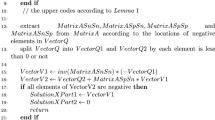Abstract
It is shown that the linear complementarity problem of finding az inR n such thatMz + q ⩾ 0, z ⩾ 0 andz T (Mz + q) = 0 can be solved by a single linear program in some important special cases including those whenM or its inverse is a Z-matrix, that is a real square matrix with nonpositive off-diagonal elements. As a consequence certain problems in mechanics, certain problems of finding the least element of a polyhedral set and certain quadratic programming problems, can each be solved by a single linear program.
Similar content being viewed by others
References
L.M. Bregman, “The method of successive projection for finding a common point of convex sets”,Soviet Mathematics Doklady (transl.) 6 (1965) 688–692.
L.M. Bregman, “The relaxation method of finding the common point of convex sets and its application to the solution of problems in convex programming”,USSR Computational Mathematics and Mathematical Physics (transl.) 7 (1967) 200–217.
R. Chandrasekaran, “A special case of the complementary pivot problem”,Opsearch 7 (1970) 263–268.
R.W. Cottle, Private communication (April 8, 1975).
R.W. Cottle and R.S. Sacher, “On the solution of large, structured linear complementarity problems: I”, Tech. Rept. 73-4, Department of Operations Research, Stanford University (1973).
R.W. Cottle, G.H. Golub and R.S. Sacher, “On the solution of large, structured linear complementarity problems: III”, Tech. Rept. 74-439, Computer Science Department, Stanford University (1974).
R.W. Cottle and G.B. Dantzig, “Complementary pivot theory of mathematical programming”,Linear Algebra and its Applications 1 (1968) 103–125.
R.W. Cottle and A.F. Veinott, “Polyhedral sets having a least element”,Mathematical Programming 3 (1969) 238–249.
C.W. Cryer, “The method of Christopherson for solving free boundary problems for infinite journal bearings by means of finite differences”,Mathematics Computation 25 (1971) 435–443.
C.W. Cryer, “The solution of a quadratic programming problem using systematic overrelaxation”,SIAM Journal on Control 9 (1971) 385–392.
C.W. Cryer,Free boundary problems, to appear.
G.B. Dantzig,Linear programming and extensions (Princeton University Press, Princeton, N.J., 1963).
I.I. Eremin, “The relaxation method of solving systems of inequalities with convex functions on the left sides”,Soviet Mathematics Doklady (transl.) 6 (1965) 219–222.
M. Fiedler and V. Pták, “On matrices with nonpositive off-diagonal elements and positive principal minors”, CzechoslovakMathematical Journal 12 (1962) 382–400.
C.E. Lemke, “Recent results on complementarity problems”, in: J.B. Rosen, O.L. Mangasarian and K. Ritter, eds.,Nonlinear Programming (Academic Press, New York, 1970) pp. 349–384.
O.L. Mangasarian,Nonlinear Programming (McGraw-Hill, New York, 1969).
T.S. Motzkin and I.J. Schoenberg, “The relaxation method for linear inequalities”,Canadian Journal on Math. 6 (1954) 393–404.
K.G. Murty, “On the number of solutions to the complementarity problems and spanning properties of complementary cones”,Linear Algebra and its Applications 5 (1972) 65–108.
R. Sacher, “On the solution of large, structured linear complementarity problems: II”, Tech. Rept. 73-5. Department of Operations Research, Stanford University (1973).
R. Saigal, “A note on a special linear complementarity problem”,Opsearch 7 (1970) 175–183.
R. Saigal, “Lemke's algorithm and a special linear complementarity problem”,Opsearch 8 (1971) 201–208.
R. Saigal, “On the class of complementary cones and Lemke's algorithm”,SIAM Journal on Applied Mathematics 23 (1972) 46–60.
A. Tamir, “Minimality and complementarity properties associated with Z-functions”,Mathematical Programming 7 (1974) 17–31.
Author information
Authors and Affiliations
Additional information
Research supported by NSF Grant GJ 35292.
Rights and permissions
About this article
Cite this article
Mangasarian, O.L. Linear complementarity problems solvable by A single linear program. Mathematical Programming 10, 263–270 (1976). https://doi.org/10.1007/BF01580671
Received:
Revised:
Published:
Issue Date:
DOI: https://doi.org/10.1007/BF01580671




